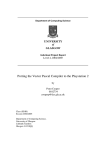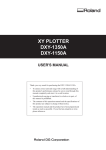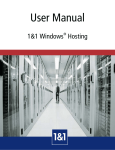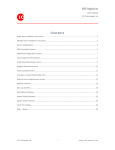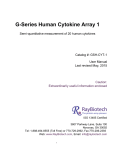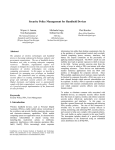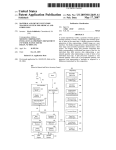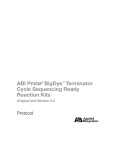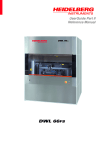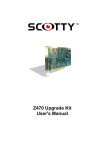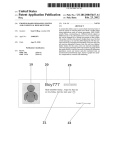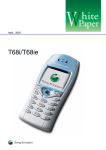Download Methods and apparatus related to document processing based on a
Transcript
US008l26837B2 (12) United States Patent (10) Patent N0.: Stollman (54) US 8,126,837 B2 (45) Date of Patent: METHODS AND APPARATUS RELATED TO Feb. 28, 2012 FOREIGN PATENT DOCUMENTS DOCUMENT PROCESSING BASED ON A Ep 1026867 A2 8/2000 DOCUMENT TYPE OTHER PUBLICATIONS (76) Inventor: Jeff stollman’ Chesterbrook’ PA (Us) Javacool Software “EULAlyZerTM 1.2 Analyze license agreements (*) Notice: Subject to any disclaimer’ the term ofthis for interesting words and phrases” [online], [retrieved on Jul. 11, patent is extended Or adjusted under 35 2008]. U'S'C~ 154(1)) by 733 days‘ wjavacoolsoftware.com/eulalyZer.html>. (2 pgs). Retrieved from the Internet: <URL: http://ww Krishna, P. Radha et al., An ER(EC) Framework for e-Contract (21) APPI' NO. 12/236,257 Modeling, Enactrnent and Monitoring, Data & Knowledge Engineer ing, vol. 51, Oct. 2004, pp. 31-58. (22) Filed. sep_ 23, 2008 Schoop, Mareike, A Language-Action Approach to Electronic Nego tiations, Systems, Signs & ActionsiAn International Journal on (65) Prior Publication Data Communication, Information Technology and Work, vol. I, No. l, 2005, pp. 62-79. Us 2010/0074524 A1 M313 25, 2010 Narendra, Nanjangud C., Generating Correct Protocols from Con tracts: A Commitment-Based Approach, 2008 IEEE Congress on (51) Int- ClG06F 1 7/00 (2006.01) Services 2008iPart I, pp. 407-414. International Search Report and Written Opinion of the International G06N 7/00 G06N 7/08 (2006.01) (2006.01) Searching Authority for PCT/US2009/057975 dated May 10, 2010, 18 pages. (52) US. Cl. (58) Field of Classi?cation Search ................... .. 706/55 ....................................................... .. Primary Exammer * Mlchael B Holmes See application ?le for complete search history. (74) A110""6)’, Agent) 0" Firm * Cooley LLP (56) 706/55 _ References Cited (57) _ _ ABSTRACT In one embodiment, a method includes receiving a portion of text from a document. A document type is associated With the document based on at least one of the portion of text or an identi?er associated with the document. The method also US' PATENT DOCUMENTS l iggrgztlal' 732993504 B1 11/2007 Tiller et ai‘ 7,303,706 B2 12/2007 Markham et a1, includes selecting, based on the document type, a document 7,350,226 B2 2004/0205342 A1 3/2008 Moriconi et a1. 10/2004 Roegner template having a plurality of sections. Each section from the plurality of sections being associated with a document cat gisgggfit a1‘ egory. At least one section from the plurality of sections 2007/0268922 A1 11/2007 Dougan et al. 2008/0080372 A1 4/2008 Cai et al. 2008/0109871 A1 5/2008 Jacobs including at least One Policy Preference 30 Claims, 6 Drawing Sheets ------------------------ ~‘ ‘,-.-_~~ Master Template 8 Parsing Functions @ 1_—-~ - l I lI I I I Document Parsing I Function Q Master Template T ~- --------------------- . ‘_' Document Parsing "7 | Master Template U | Function R U.S. Patent Feb. 28,2012 Sheet 1 of6 US 8,126,837 B2 Document Analysis Engine jig Template Module @ Template Q Parsing Module @ D H: I 164 $32122" ling Requesting Entity liq Document Provider? 170 Template Module @ """"""""" User 24_O Master v ‘7 Template D \5 Template Database 211 ; \ Template \\ ________________________________________ __ Definition 5' ‘: TemplateE_§‘\~~~~ Master ,5.E / / /\ \Module ,\/\ a22g = I =' w _______4I I __ _ " __ ~ ‘l’ 95 j'grnplges T-"'"" emp l ate A f‘ Template Temp | ate G B Template F E a " ( __________________ l S 274 210 FIG. 2 5 " US. Patent Feb. 28, 2012 Sheet 2 of6 US 8,126,837 B2 Master Contract Tempiate QQQ ----------------- -, Condition/Action E E gorltracg Condition/Action F S Condition/Action G ec ‘on User-Speci?c Contract & Contract g Contract éCondition I 5 Section 2 ECondition J . I E ; Action K User Se‘ection Section 1 -------- --> Contract Section 25 Action M aS SCorztrac; icondmon L Action N ec ion 5 Action K I 345 FIG. 3 I | _ __ _ .. Master | Template 8 Parsing Functions @ Document Parsing Master 4. Function Q Template T Document Parsing Function R Master Template U FIG. 4 . Condition/Action E .. I US. Patent Feb. 28, 2012 Sheet 3 of6 Receive a portion of a contract @ l Determine a contract type _5_1_Q l Select a contract template based on the contract type _5_2_Q l Select a contract parsing function based on the contract type @152 Y Determine a meaning of the portion of the contract based on a contract parsing function 55g l Associate and compare the meaning of the portion of the contract with a section of contract template E l Perform an action based on the comparison of the meaning of the portion of the contract with the section of the contract template when a condition is satis?ed @ FIG. 5 US 8,126,837 B2 US. Patent Feb. 28, 2012 Sheet 4 of6 US 8,126,837 B2 Parsing Function Database QQQ Contract Template Database @ Document Analysis Engine m Master ContractI—'—_"'—Template @ @ Module Parsing _6__1__2_)' Condition! Contract |' \ \ ‘ Action A1 Section I Contract §2_Q \I ~ \ \ \ Condition! | Action A2 @ ‘L ! \ Condition! \ Action 81 __ \ Contra igld‘t'g'g ‘°f‘. Conditionl Section \ oo_4_ \ \ | I Template Module 614I \\ — Action B3 __ Parsing Function __ \ | N / | Condmon/ \ \/ /Plreference Contract . Action C1 / Section I "C CH’ I eau on non Action / _6_Q_§ D f / ’ / A/ / / MOdUIG w \ \ User Preferences 618 — FIG. 6 \ / -— \ 7 \ § \ / ‘ ‘R l V —- 624 | \ __ \ ~ \ \ \ \ v 1; 622 US. Patent Feb. 28, 2012 Sheet 5 of6 US 8,126,837 B2 Entity X Document _ Document Analysis Engine m Entity Y 770 FIG. 7 Receive at a document analysis engine at least a portion of a contract in w 800 response to an update request V Determine that the portion of the contract has changed W 810 V Analyze the portion of the contract based on a contract template and W 820 based on a parsing function V Perform an action in response to the analysis FIG. 8 W 830 Provider @ US. Patent Feb. 28, 2012 Sheet 6 of6 US 8,126,837 B2 Policy Metric 920 J Time —--—> FIG. 9 US 8,126,837 B2 1 2 METHODS AND APPARATUS RELATED TO DOCUMENT PROCESSING BASED ON A DOCUMENT TYPE FIG. 7 is a schematic block diagram that illustrates a docu ment analysis engine con?gured to communicate With a ?rst entity in response to an analysis of a document requested by a second entity, according to an embodiment. FIG. 8 is a ?owchart that illustrates a method for analyZing a portion of a contract in response to an update request, according to an embodiment. FIG. 9 is a schematic graph that illustrates a trend of tWo policy metrics versus time, according to an embodiment. BACKGROUND Embodiments relate generally to document processing, and, in particular, to methods and apparatus related to pro cessing of at least a portion of a document based on a docu ment template. As society becomes more impersonal through such Wide DETAILED DESCRIPTION area media as the World-Wide Web, it has become desirable to A document analysis engine can be con?gured to process, formally document rules of engagement betWeen parties pro in response to a request from a user, a portion of a document viding/using services of one another. This has led to an explo based on a document template. Speci?cally, the document analysis engine can be con?gured to compare a section of the document template to the portion of the document based on an sion of contractual documentation (often crafted by the ser vice provider) to Which parties must formally or impliedly agree in order to avail themselves of the products and/or services covered by such contracts. The need to approve and recon?rm lengthy and frequently changing documents including End-User-License Agreements (EULAs), Terms interpretation of the portion of the document using a parsing function. The parsing function can be con?gured to interpret 20 the portion of the document based on an ontology and/or a semantic rule. In some embodiments, an action can be per and Conditions, and Privacy Policies often poses such an formed and/or triggered based on Whether the comparison imposition on productivity that many users agree to the terms of such contracts Without taking the time to read them and satis?es a threshold condition. Moreover, the document analysis engine can function as a policy ?lter on behalf of the understand the obligations and restrictions imposed by them. 25 such risks because of the burden of having to read and under stand these contracts Which can be lengthy and ?lled With legalese that a typical user may not understand4even if they take the time to read the document in its entirety. Thus, a need exists for methods and apparatus for process ing at least a portion of a document based on a document user by applying policies de?ned Within the document tem plate. In some embodiments, a condition/ action combination can be referred to as a policy preference. In some embodiments, the document template can be cus Often, users are uncomfortable With this exposure, but take tomiZed by a user and/or can be de?ned based on a master 30 template. In some embodiments, the document template and/ or the parsing function can be selected based on an identi?er and/or a term associated With the document template. In some embodiments, the document can be associated With target template. SUMMARY 35 gered can be based on a comparison of a document template With a document that is associated With target content. For example, if the document is a contractual document associ In one embodiment, a method includes receiving a portion of text from a document. A document type is associated With the document based on at least one of the portion of text or an identi?er associated With the document. The method also includes selecting, based on the document type, a document 40 ated With target content requested by the user (e.g., an End User-License Agreement (EULA) or a privacy policy associ ated With a Web page), the document analysis engine can be con?gured to determine based on a parsing module and a template having a plurality of sections. Each section from the plurality of sections being associated With a document cat user-de?ned template Whether or not a speci?ed portion of the document Would be acceptable to the user. In some embodi egory. At least one section from the plurality of sections including at least one policy preference. content requested for, for example, vieWing by the user. In some embodiments, the actions performed and/or trig 45 BRIEF DESCRIPTION OF THE DRAWINGS ments, the document analysis engine can be con?gured to identify portions of the document that should be revieWed by the user. In some embodiments, the document analysis engine can be con?gured to restrict or alloW access to the target FIG. 1 is a schematic block diagram that illustrates a docu ment analysis engine con?gured to process a document, 50 appended claims, the singular forms “a,” “an” and “the” according to an embodiment. FIG. 2 is a schematic block diagram that illustrates tem include plural referents unless the context clearly dictates otherWise. Thus, for example, the term “a template” is plates de?ned by a user using a template de?nition module, according to an embodiment. FIG. 3 is a schematic block diagram that illustrates a user speci?c contract template de?ned based on a master contract intended to mean a single template or a combination/collec 55 FIG. 4 is a schematic block diagram that illustrates a set of document parsing functions associated With a set of master any type of document. 60 FIG. 1 is a schematic block diagram that illustrates a docu ment analysis engine 110 con?gured to process (e.g., ana according to an embodiment. FIG. 5 is a ?owchart that illustrates a method for analyZing a portion of a contract based on a contract template, according lyZe) a document 164, according to an embodiment. The document 164 (or portion of a document) can be delivered to the document analysis engine 110 from a document provider to an embodiment. FIG. 6 is a schematic block diagram that illustrates a docu tion of templates. Also, many of the embodiments are described in connection With processing of contracts by Way of example only. Any of the embodiments described herein can be generally applied to the processing (e.g., analysis) of template, according to an embodiment. templates and associated With a set of customiZed templates, content based on the analysis of the document. It is noted that, as used in this Written description and the 65 180 over a netWork 170 in response to a request from a ment analysis engine con?gured to analyZe portions of a requesting entity 140 (e. g., a computing entity such as a contract, according to an embodiment. mobile device, personal computer, or a server that can be US 8,126,837 B2 3 4 controlled a (human) user). Speci?cally, the document analy the parsing function to interpret a portion of a document 164. sis engine 110 can be con?gured to interpret (and associate an interpretation With) at least a portion of the document 164 In some embodiments, the interpretation can be based on using a parsing module 150. The document analysis engine probabilistic rules (e. g., probabilistic matching With an inter pretation) encoded Within the document parsing function 110 can also be con?gured to perform (and/ or trigger) an action associated With the document 164 based on a compari 152. In some embodiments, the document parsing function 152 can be con?gured to interpret the document 164 based on son of the interpretation (e.g., the meaning) of the portion of natural language processing techniques. the document 164 With one or more sections included in a In some embodiments, the document parsing function 152 can include, for example, various tools that can be used by the template 162 using a template module 160. In some embodi ments, the interpretation can also be referred to as a meaning. In some embodiments, the document 164 can be de?ned parsing module 150 to process (e.g., physically process) the document 164. For example, the document parsing function based on one or more types of documents such as, for 152 can include an optical character reader (OCR) function example, a contract (e.g., a lease contract, a EULA, a terms and conditions contract, a real property contract, etc.), a book (e.g., a compilation), an article (e.g., a publication, a journal that can be used to convert text and/ or media included in a paper document into an electronic format that can be pro article, a neWspaper article), a user manual, a technical refer ence document, a compliance report, and so forth. In some embodiments, for example, the document parsing function embodiments, the document 164 can include text (e.g., digi tized text, digitized text acquired from a Web page) and/or 152 can include a speech detection/recognition system that can translate propagating sound Waves and/or digitized rep resentations of sound Waves (e.g., speech, music) to text that media (e.g., images (maps, photos, technical draWings, ?oW cessed by the document analysis engine 110. In some 20 charts, etc.), video, audio). In some embodiments, the docu can then be processed by the document analysis engine 110. ment 164 can be processed, for example, by the document In some embodiments, the document parsing function 152 of the parsing module 150 can be con?gured to parse the document 164 (e.g., parse text and/or media included in the analysis engine 110 so that the document 164 can be elec tronically processed by the document analysis engine 110. In some embodiments, the document 164 can be an entire docu 25 ment (or multiple documents) or a portion of a document (or included Within a template 162. In some embodiments, the document parsing function 152 can be con?gured to rear a portion of multiple documents). One or more sections Within the template 162 used during analysis of the document 164 can include text (e.g., digitized text) and/ or media (e. g., images, video, audio). In some range (e.g., move, combine) portions of the document 164 so that they correspond With sections included Within a template 30 embodiments, the sections Within a template can be de?ned so that they correspond With one or more sections associated With the document 164. In some embodiments, the template 162 can include sections that typically appear in a particular type of document identi?ed for analysis using the document document) into sections that correspond With sections 35 162. In other Words, the document parsing function 152 can be con?gured to prepare the document for comparison With the template 162. In some embodiments, for example, por tions of the document 164 can be rearranged by the parsing module 150 based on semantic relationships betWeen Words analysis engine 110. and/or the relationships betWeen sections Within the template In some embodiments, a section Within the template 162 can include key Words that can be used by the template rangedportions of the document 164 (e.g., neW portions of the 1 62. Accordingly, interpretations can be associated With rear Words can be in a particular order and/or can be related document that are de?ned based on original portions of the document 164 that have been parsed and combined into the neW portions). Moreover, the template 162 and the document according to speci?ed semantic rules. parsing function 152 can be de?ned so that they are compat module 160 during comparison of the section of the template 162 With the document 164. In some embodiments, the key 40 ible With (e. g., consistent With, customized for) one another. In some embodiments, the template 162 can included stan dardized sections and/or customized sections de?ned by, for example, a user (e.g., the requesting entity 140). In other 45 One or more sections Within the template 162 can be asso ciated With one or more conditions and/ or actions that can be Words, one or more sections of the template 162 can include standardized language adopted by, for example, a governing body or organization. Accordingly, the document 164 can be compared With standardized language included in the tem plate 162. More details related to parsing functions are discussed in connection With FIG. 4. performed (triggered) based on Whether or not the conditions 50 The parsing module 150 can be con?gured to interpret (e. g., determine a meaning for, extract a meaning from) the are satis?ed. For example, template 162 can include one or more template sections that can be associated With one or more conditions and/or one or more actions. In some embodi ments, the sections of the template 162 and associated con document 164 based on one or more document parsing func ditions/actions can collectively be referred to as a template tions such as document parsing function 152 shoWn in FIG. 1. Speci?cally, the document parsing function 152 can be con ?gured to parse at least a portion of text and/or a portion of a policy. In some embodiments, multiple conditions can 55 media object (e.g., an image, a video, an audio snippet) from the document 164. The document parsing function 152 can be triggered) by the template module 160 based on a comparison con?gured to interpret one or more portions, or groups of one or more portions, parsed from the document 164. In some embodiments, the document parsing function 152 correspond With an action and/or multiple actions can corre spond With a condition. In some embodiments, a condition/ action combination can be referred to as a policy preference. Speci?cally, one or more actions can be performed (and/or 60 of a section of template 162 With the interpretation of a can include, for example, language processing portions (e.g., portion of the document 164 by the parsing module 150. For example, the template module 160 can be con?gured to per language processing functional portions) that are de?ned form (and/or trigger) an action based on Whether or not a comparison of an interpretation associated With a portion(s) based on one or more ontological structures and/or one or more semantic rules. The ontological structure(s) and/or the 65 of the document With a section Within the template 162 sat semantic rule(s) included Within the language processing por is?es one or more criteria. Although not shoWn, in some tion(s) of the document parsing function 152 can be used by embodiments, the actions performed (and/ or triggered) by the US 8,126,837 B2 5 6 document analysis engine 110 can be de?ned in a database (e.g., a template database) that can be accessed by the tem (for use in processing the document 164) based on one or more identi?ers and/or one or more terms associated With the plate module 160. (and/or triggered) by the template module 160 in response to document 164. For example, an identi?er, such as an elec tronic tag (e.g., metadata, a link) and/or one or more terms (e.g., a title/heading, a paragraph) associated With one or a comparison of a portion of the template 162 (e. g., a section) more portions of the document 164 (e.g., the entire document With the interpretation of the document 164 by the parsing module 150 can be, for example, blocking and/or alloWing 164), can be received, interpreted, and used by the document analysis engine 110 to select the document parsing function 152 and/or the template 162 (or template-policy). The iden ti?er(s) and/or term(s) can be received by the document In some embodiments, the actions that can be performed access to (e.g., vieWing privileges to, editing privileges to) one or more portions of the document 164 by the requesting entity 140. In some embodiments, the document analysis engine 110 can be con?gured to identify certain portions of the document 164 that may require further revieW, for example, by the requesting entity 140. In some embodiments, analysis engine 110 in response to a request from the docu ment analysis engine 110 and/or extracted from one or more portions of the document 164 (and/ or data associated With the document 164). if the document 164 is a contract, the document analysis For example, the document parsing functions 152 (or a engine 110 can be con?gured to identify one or more terms or portion thereof) used by the parsing module 150 and/or the template 162 (or a portion thereof) used by the template sections associated With the contract that should be accepted or rejected. In some embodiments, the document analysis engine 110 can be con?gured to suggest changes to the docu ment 164 based on the processing of the document 164. In some embodiments, the document analysis engine 110 can be con?gured to send a noti?cation to, for example, the request ing entity 140 based on the content of the document 164. In some embodiments, the document analysis engine 110 can be con?gured to provide an assessment of the document 20 25 164 to the requesting entity 140. For example, if the document is a contract, the document analysis engine 110 can identify portions of the document 164 as more restrictive, or less restrictive, than speci?ed sections of the template 162. In some embodiments, the document analysis engine 110 (e. g., the template module 160 of the document analysis engine 110) can provide options With respect to any of the actions, for example, to the requesting entity 140. In some embodiments, providing an option can be considered (or encoded as) an action. For example, the document analysis engine 110 can be con?gured to provide options With respect 30 35 analysis engine 110) of a document parsing function(s) and/ In some embodiments, the identi?er(s) and/or the term(s) associated With one or more portions of the document 164 can be received, interpreted, and used during a preliminary pro 45 ditions and/or actions as related to templates are discussed in connection With FIGS. 3 and 5. In some embodiments, the template 162 (e.g., sections of the template 162 With associated conditions and/or actions, sections of the template 162 associated With a policy prefer 50 (also can be referred to as master document templates). In some embodiments, the template 162 can be stored in a tem different entity (not shoWn) than the requesting entity 140. In ment 164 by the template module 160 based a user preference (e. g., a policy, a condition). More details related to templates are discussed in connection With FIGS. 2 through 9. In some embodiments, the document parsing function 152 (or a portion thereof) and/or the template 162 (e.g., a section With associated conditions and/or actions) can be selected sis of an identi?er(s) and/or a term(s) associated With the document 164. In some embodiments, the preliminary pro cessing can be performed based on a default (or generalized) document parsing function (not shoWn) and/ or a default (or generaliZed) template (not shoWn). After the document pars 55 the template 162 can be de?ned, at least in part, based on one or more preferences of the requesting entity 140 and/or a some embodiments, the template 162 (or a portion of the template 162) can be applied to only a portion of the docu ces sing time period so that the document parsing function 152 and/or a template 162 (or template-policy) can be selected. In other Words, the document parsing function 152 and/or the template 162 can be selected from a library of document parsing functions (not shoWn in FIG. 1) and/or a library of templates (not shoWn in FIG. 1), respectively, based on analy ence) can be de?ned based on one or more master templates plate database (not shoWn) Where the template 162 can be accessed by the template module 160. In some embodiments, option in a prompt) to the requesting entity 140 (or a different entity) to accept (e. g., con?rm) or reject the selection (or portions of the selection) of the template(s) and/or document parsing function(s). In some embodiments, the document analysis engine 110 can be con?gured so that the requesting 40 or a template(s). example, one or more options can be accompanied by a high lighted portion and/ or an interpretation (e.g., a meaning) of a speci?ed portion(s) of the document 164 as determined by the document analysis engine 110. More details related to con document type, the parsing module 150 can be con?gured to determine a meaning of the portion(s) of the document 164 based on a parsing function (such as document parsing func tion 152) corresponding With a EULA document type. Like Wise, the template module 160 can be con?gured to apply one or more templates (such as template 162) based on the portion (s) of the document 164 being de?ned based on a EULA document type. In some embodiments, the document analysis engine 110 can be con?gured to present an option (e.g., an entity 140 (or a different entity) can manually make a selec tion (or override an automatic selection by the document Whether or not to block/alloW access to a speci?ed portion(s) of the document 164 and/or options With respect to accepting/ denying a speci?ed portion(s) of the document 164. In some embodiments, the options (and/or actions) can be accompa nied by information de?ned based on the processing of the document 164 by the document analysis engine 110. For module 160 to process the document 164 can be selected based on a document type associated With the document 164 based on analysis of an identi?er and/ or a term from the document 164. For example, if one or more portions of the document 164 is identi?ed as being de?ned based on a EULA 60 ing function 162 and the template 152 have been selected, the document parsing function 162 can be used by the parsing module 150 and/or the template 152 can be used by the template module 160 to process the portion(s) of the docu ment 164 during a secondary processing time period. In some embodiments, processing of the document 164 can be performed in an iterative fashion by the document analysis engine. For example, in some embodiments, analysis of the document 164 by the template module 160 and/or the parsing 65 module 150 can be performed iteratively to re?ne an analysis of the document 164. In some embodiments, the iterative processing by the template module 160 can be performed based on different templates (not shoWn) during different US 8,126,837 B2 7 8 iterations. In some embodiments, the iterative processing by the document parsing function 152 can be performed based engine 110 (e.g., the template module 160 of the document analysis engine 110) can, for example, block and/or alloW on different document parsing functions (not shoWn) during access (by the requesting entity 140 or a different entity) to different iterations. In some embodiments, the document parsing functions and/ or the templates can be selected based one or more portions of the target content based on processing of the document 164. In some embodiments, if the document 164 is a contract, the document analysis engine 110 can be on threshold conditions de?ned by, for example, the request ing entity 140. con?gured to identify one or more terms or sections associ In some embodiments, a ?rst analysis of a document 164 may produce a ?rst level of results (e.g., a hierarchical cat ated With the contract that could/ should be accepted or rejected before the target content is accessed. In some embodiments, the document analysis engine 110 can be con egoriZation). A second analysis of the document 164 may produce a second level of results based on or unrelated to the ?gured to send a noti?cation to, for example, the requesting ?rst level of results. The ?rst analysis and the second analysis entity 140 about the target content based on the content of the document 164 associated With the target content. can be performed by the document analysis engine 110 using different or same templates and/or different or same docu In some embodiments, an identi?er and/ or term that can be used to select the document parsing function 152 (e. g., select from a library of document parsing functions) and/or the template 162 (e.g., select from a library of templates) can be associated With the target content. For example, the identi?er ment parsing functions. In some embodiments, the document analysis engine 110 can be con?gured to analyZe the docu ment 164 multiple times and prompt a user (e.g., the request entity 140) to select one or more of the results of the analysis. Although not shoWn in FIG. 1, in some embodiments, the parsing module 150 and/or the template module 160 can and/or term can be associated With a link (e.g., a hyperlink, a apply different document parsing functions (or portions thereof) and different templates (or portions thereof) to dif universal resource locator (URL)) (if the target content is a Webpage) used to access the target content or included Within the target content. ferent portions of the document 164. For example, if the document analysis engine 110 determines that a ?rst portion ment analysis engine 110 can be a hardWare-based module of the document 164 corresponds With a EULA (e.g., is a EULA document type) and that a second portion of the docu ment164 corresponds With a real estate contract (e. g., is a real estate contract document type), the ?rst portion of the docu ment 164 can be processed based on a document parsing function associated With the EULA and the second portion of 20 In some embodiments, one or more portions of the docu 25 (e.g., a digital signal processor (DSP), a ?eld programmable gate array (FPGA)) and/or a softWare-based module (e.g., a module of computer code, a set of processor-readable instruc tions that can be executed at a processor (Which could be associated With a memory)). In some embodiments, for 30 the document 164 can be processed based on a document parsing function associated With the real estate contract. example, the document analysis engine 110 can be encoded Within an application (e.g., a java based application, a Web based application) that can be installed on and/or served to, for example, a personal computer. Any of the operations (e. g., In some embodiments, one or more document parsing functions and/or one or more templates can be selected based functions) performed by the document analysis engine 110 on a preference of a user such as the requesting entity 140. For 35 can be included Within one or more modules. For example, one or more operations performed by the parsing module 150 and/or the template module 160 can be combined into a single module or divided in multiple modules (including modules example, the user can de?ne a priority preference that can be used by the document analysis engine 110 to select one or more templates over another template, or to select one or more document parsing functions over another document that are not shoWn). parsing function. In some embodiments, one or more docu 40 Although not shoWn, in some embodiments, the document ment parsing functions and/or templates can be customiZed and associated With an identi?er associated With the request analysis engine 110 can be made available as a Web service. For example, the document analysis engine 110 can be ing entity 140. In other Words, the customiZed document parsing functions and/or templates can be associated With the requesting entity 140 using the identi?er. In response to a request from the requesting entity 140 to process the docu ment 164, the document analysis engine 110 can use the identi?er to fetch the customiZed document parsing functions and/ or templates so that the document 164 can be processed based on the customiZed document parsing functions and/or invoked via a Web broWser. In some embodiments, the docu ment analysis engine 110 can be accessed via an account 45 With the document analysis engine 110 can be made available and invoked via an application programming interface (API). 50 templates. In some embodiments, the document 164 can be associated With target content (not shoWn), and processing of the docu ment 164 can be triggered in response to a request by the requesting entity 140 to access the target content. For example, the target content can be an application that can be doWnloaded or associated With a Webpage (e.g., content included Within a Webpage), and the document 164 can be a terms and condition contract and/or EULA associated With (e.g., referenced in, linked to) the target content. In some (e.g., a user account) associated With, for example, a request ing entity. In some embodiments, the functionality associated 55 In some embodiments, any of the operations performed by the document analysis engine 110 can be manually triggered by, for example, the requesting entity 140 (or a different entity). In some embodiments, any of the operations per formed by the document analysis engine 110 can be triggered by an entity (not shoWn) other than the requesting entity 140. For example, the actions and/ or options canbe presented to an entity different than the requesting entity 140. In some embodiments, one or more portions of templates (such as template 162) and/or document parsing functions (such as 60 document parsing function 152) can be de?ned by an entity different than the requesting entity 140. embodiments, one or more portions of the target content can In some embodiments, the document provider 180 can be be analyZed in addition to the document 164 (in Which case, any entity that can send (e.g., transmit, provide) the document 164 to the document analysis engine 110 for processing. In the target content can be referred to as a document). Any of the actions and/or options (Which can be actions) performed (and/or triggered) by the document analysis engine 110 With respect to the document 164 can be applied to the target content as Well. For example, the document analysis some embodiments, the document provider 180 can be con 65 ?gured to send the document 164 to the document analysis engine 110 in a format and/ or based on a protocol that can be compatibly processed by the document analysis engine 110. US 8,l26,837 B2 9 10 In some embodiments, the document analysis engine 110 can have one or more modules con?gured to convert (e.g., trans (e.g., pointers) back to the master templates 210 (and/ or con ditions and/or actions included Within the master templates late) the document 164 into a format (e. g., a protocol) that can 210). In such embodiments, the master templates 210 (and/or be compatibly processed by the document analysis engine associated conditions/actions) can be stored in a location(s) 110. In some embodiments, the document provider 180 can be, for example, a Wired device and/or a Wireless device such (e.g., at the document analysis engine 110) Where they can be accessed by the template module 260 When processing a as, for example, a computing entity (e. g., a personal comput ing device), a mobile phone, a personal digital assistant document. (PDA), and/or a server (e.g., a Web server/host). The netWork 170 can be, for example, a local area netWork (LAN) and/or a Wide area netWork (WAN). In some embodi de?nition module 220 can be included Within a document ments, the netWork 170 can include one or more Wired and/or Wireless segments. Although not shoWn, the document analy sis engine 110, the document provider 180 and/or the request can be used to not only de?ne a template (and associated actions/conditions), but also can be used to process (e. g., analyZe) a document based on the template. ing entity 140 can be included Within a single computing environment (e. g., a personal computer). Although not FIG. 3 is a schematic block diagram that illustrates a user speci?c contract template 310 de?ned based on a master shoWn, in some embodiments, a document can be received at 20 contract template 300, according to an embodiment. The master contract template includes three contract sections 345, contract section 1, contract section 2, and contract section 3, that are each associated With various combinations of condi 25 the master contract template 300 is associated With three different condition/action combinations E, F, and G. Contract section 2 has tWo conditions4condition I and condition Jiassociated With a single action K. Contract section 3 has a Although not shoWn, in some embodiments, the template analysis engine (such as the document analysis engine 110 shoWn in FIG. 1). Accordingly, the document analysis engine a computer via, for example, a universal serial bus (U SB) port or a different port (e.g., ?reWire port). The document can be scanned via a scanner and transmitted to the computer via the USB port. The document can be analyZed by a document analysis engine installed at or accessed from (e.g., via a tions and actions (policy preferences). Contract section 1 in network) the computer. In some embodiments, the document analysis engine 110 can be con?gured to analyZe documents that include text and/ or images related to various languages and/or cultures. In single condition L associated With three different actions M, N, and K. some embodiments, for example, the document parsing func The contract sections 345 can include text (e.g., digitiZed tion 152 can be con?gured to translate one or more portions of text) and/or media (e. g., images, video, audio) associated the document 164 for comparison With a section of the tem plate 162. 30 In some embodiments, any portion of the document analy sis engine 110 can be con?gured to alloW for, prompt and/or require human interaction (e.g., intervention). For example, the document analysis engine 110 can be con?gured to prompt a user for approval by the user or manual intervention 35 With different provisions and/or clauses of a contract. For example, the provisions (Which can also be referred to as categories) can include, for example, a severability provision (or clause), a choice of laW provision (or clause), a Warranty provision (or clause), an indemni?cation provision (or clause), a con?dentiality provision (or clause), and so forth. As shoWn in FIG. 3, the user-speci?c contract template 310 (e. g., editing, selection) by the user for any action taken by the document analysis engine 110. includes a subset of the contract sections 345 and conditions/ FIG. 2 is a schematic block diagram that illustrates tem plates 274 de?ned by a user 240 using a template de?nition module 220, according to an embodiment. The templates 274 actions from the master contract template 300. Speci?cally, the user-speci?c contract template 310 includes contract sec tion 1, Which is associated With condition/ action E, and con tract section 2B, Which is associated With condition I and action K. In this embodiment, contract section 2B is a modi ?ed version of contract section 2. Contract section 3 from the master contract template 300 is not included in the user 40 can be referred to as a set of templates 274 or as a library of templates 274. The templates 274 are de?ned based on master templates 210 and, in some embodiments, each of the tem plates 274 can be referred to as a child template or a custom iZed template. The templates 274 include template A, tem plate B, and template C, and the master templates 210 include master template D, master template E, and master template F. For example, in this embodiment, templateA is de?ned by the 45 310 is de?ned based on selections by a user from the master user 240 via a template de?nition module 220 based on mas ter template D. Also, in this embodiment, template C and 50 template G are de?ned by the user 240 via a template de?ni tion module 220 based on master template F. In some embodi some embodiments, modifying one or more of the contract 55 network. Each of the templates 274 can include conditions and/or actions (e.g., a policy preference) that can be used by the template module 260 When processing one or more portions of a document (such as document 164 shoWn in FIG. 1). In some embodiments, the templates 274 can include references In some embodiments, a set of policy preferences (condi tion/action pairs) can be de?ned based on a global selection In this embodiment, the templates 274 are included in a template database 270 that can be accessed by a template module 260. In some embodiments, the template database 270 can be stored in a memory such as a local memory (e.g., a hard drive, a random-access memory (RAM)) and/or a distributed database that can be accessed, for example, via a contract template 300. In some embodiments, the selections by the user can be performed via a template de?nition module such as template de?nition module 220 shoWn in FIG. 2. In sections 345 (such as the modi?cation of contract section 2 into contract section 2B) When de?ning a user-speci?c con tract policy may not be alloWed. ments, the user 240 can be a requesting entity. In some embodiments the templates 210 can be referred to as user speci?c templates 210. speci?c contract policy 310. As indicated in FIG. 3, the user-speci?c contract template 60 by a user. For example, condition/action E, condition .I/ action K, and condition L/action M can be selected and used to de?ne a user-speci?c contract (not shoWn) based on a single selectable link to this set of policy preferences. FIG. 4 is a schematic block diagram that illustrates a set of document parsing functions 450 associated With a set of mas ter templates 445 and associated With a set of customiZed templates 447, according to an embodiment. Each template 65 from the set of customiZed templates 447 is de?ned based on at least one template from the set of master templates 445. Document parsing function Q is associated With master tem US 8,126,837 B2 11 12 plate S (and customized templates de?ned based on master template for the particular contract type has not been created template S) and master template T (and customized templates by the user, the user can be noti?ed that a contract template de?ned based on master template T), and document parsing function R is associated with master template U (and custom iZed templates de?ned based on master template U). In some embodiments, each of the master templates 445 could not be identi?ed. In such instances, a document analy sis engine, for example, can be con?gured to automatically ignore the portion of the contract, analyZe the portion of the contract based on a different contract template (e.g., a default contract template) and/or different contract parsing function (e.g., a default contract parsing function), provide the user can be de?ned based on a document type. In some embodi ments, the master templates 445 can be de?ned based on with options (e.g., manually triggered options) for handling ontologies and/or semantic rules used to de?ne the parsing functions 450. For example, parsing function R and master template U (e.g., sections within the master template U and T), which is associated with parsing function R, can be de?ned based on ontologies and/or semantic rules de?ned for processing a EULA. In other words, the document templates (e. g., the master templates 445 and customiZed templates 447) can be de?ned so that they are compatible with (e.g., consistent with) the analytical processes encoded within the parsing functions 450. Accordingly, if a document selected for analysis is a EULA, parsing function R and master tem plate U can be used to analyZe the EULA. the scenario (e.g., options for ignoring the portion of the contract, etc.), and so forth. A meaning for the portion of the contract is determined based on the contract parsing function at 540. In other words, the portion of the contract can be interpreted based on the contract parsing function. If the portion of the contract includes text, the meaning can be determined based on one or more ontologies associated with the contract parsing function and/or one or more semantic rules associated with the con tract parsing function. In some embodiments, the one or more 20 FIG. 5 is a ?owchart that illustrates a method for analyZing a portion of a contract based on a contract template, according ontologies can be de?ned speci?cally for the contract type. The meaning of the portion of the contract is associated and compared with a section of the contract template at 550. The to an embodiment. In some embodiments, the method can be section can be associated with a contractual provision or a implemented using, for example, a document analysis engine. contractual term (e.g., a single word that de?nes a term, a collection of words that de?ne a term). In some embodiments, if a meaning for at least a portion of As shown in FIG. 5, a portion of a contract is received at 500. The portion of the contract associated with the contract can be received in response to a request from a user (e. g., a request 25 the portion of the contract cannot be desirably determined (e. g., determined within a speci?ed threshold accuracy) based on the contract parsing function at 540 and/or the meaning ing entity) and can include text and/or media. The portion of the contract can be associated with, for example, web content served from a web server. In some embodiments, the portion 30 of the contract can be a term within the contract, can be a provision of the contract, can be the entire contract, can be associated with multiple contracts, and so forth. As shown in FIG. 5, a contract type is determined at 510. In some embodiments, the contract type can be determined based a term (e. g., a single word, a collection of words) and/or based on an identi?er associated with the portion of the con the issue via, for example, a user-interface prompt. In some 35 embodiments, the portion of the contract (or a portion of the portion of the contract) that could not be interpreted can be automatically ignored. In some embodiments, a user can be presented with one or more portions of the portion of the contract that could not be analyZed (e. g., interpreted) and/or tract. If a contract type cannot be determined at 510, an action can be performed and/ or triggered. For example, in some embodiments, a user can be noti?ed that the portion of the cannot be associated with a section of the contract template at 550, one or more actions can be performed and/ or triggered. For example, in some embodiments, a user can be noti?ed of 40 can be presented with options (e.g., manually triggered options) for handling the portion of the contract (e.g., options for ignoring the portion of text, etc.). In some embodiments, contract cannot be analyZed. In some embodiments, one or the portion of the contract can be analyZed based on one or more portions of the portion of the contract can be provided to more different contract parsing functions until, for example, a meaning for the portion of the contract can be determined. An action is performed based on the comparison of the meaning of the portion of the contract with the section of the the user and/or the user can be prompted to make a manual decision with respect to the portion of the contract. In some embodiments, the user can trigger, for example, a document 45 analysis engine to ignore the portion of the contract cannot be contract template when at least one condition is satis?ed at analyZed. In some embodiments, the user may not be noti?ed that a contract type could not be determined and/or the portion 560. For example, access to (e. g., viewing privileges to, edit of the contract can be automatically handled, for example, by a document analysis engine. For example, a document analy sis engine can be con?gured to automatically ignore portions of the portion of the contract that cannot be analyZed. A contract template is selected based on the contract type at 520. In some embodiments, the contract template can be a 50 tion(s). For example, if the meaning of the portion of the contract is substantially different than the section of the con 55 ments, if the meaning of the portion of the contract is sub stantially different than the section of the contract template, a user can be prevented from viewing content associated with 60 corresponding with the contract template can be automati cally selected when the contract template is selected. In some embodiments, a user can be noti?ed if a contract 65 template and/or a contract parsing function cannot be associ ated with the portion of the contract. For example, if a contract tract template, a user can be noti?ed and/or a change to the portion of the contract can be suggested. In some embodi contract template de?ned based on a master contract tem plate. The contract template can include one or more sections that can be associated with conditions and/or actions. A contract parsing function is selected based on the con tract type at 530. In some embodiments, the contract parsing function can be selected based on the contract template that is selected at 520. In other words, a contract parsing function ing privileges to) one or more portions of content associated with the portion of the contract can be automatically blocked and/or allowed if the comparison of the section of the contract template with the portion of the contract satis?es the condi the portion of the contract. Although FIG. 5 is a ?owchart related to analysis of a portion of a contract, in some embodiments, the ?owchart can be used to analyZe text and/or media that can be associated with different types of documents such as a book or a journal article. In some embodiments, one or more portions of the method can be performed in a different order and/or can require human interaction in order to proceed. For example, US 8,126,837 B2 13 14 in some embodiments, the contract parsing function can be selected based on the contract type (shoWn at 530) before the contract template is selected based on the contract type (e.g., ignore, accept) With respect to, for example, document 782 as instructed in a subscription. In some embodiments, the be selected based on the contract parsing function that is selected. In some embodiments, the contract template must be approved by a user before the contract template is used to action can be performed (and/or triggered) in lieu of or in addition to the signal 766. For example, in some embodiments, entity Y can register (in a subscription) With the document analysis engine 710 to be noti?ed if a change in document 782 is detected. Signal analyZe one or more portions of the contract. FIG. 6 is a schematic block diagram that illustrates a docu analysis engine 710 detecting a change in document 782 (shoWn at 520). In such instances, the contract template can 766 can be sent to entity Y in response to the document ment analysis engine 610 con?gured to analyZe portions of a (after being prompted by entity X to analyZe the document contract 620, according to an embodiment. Speci?cally, por tion 624 and portion 622 of the contract 620 are analyZed 782). The change canbe detectedbased on a stored copy (e. g., a cached copy) of the document 782. The signal 766 can based on a parsing function 652 received from a parsing include information related to the change (e.g., types of change(s), assessment of the change (more restrictive lan guage, less restrictive language, etc.)). In some embodiments, function database 650, and based on a master contract tem plate 600 from a contract template database 660. The docu ment analysis engine include a parsing module 612, a tem plate module 614, and a preference module 616. Portion 624 of the contract 620 is interpreted at the parsing module 612 based on parsing function 652. A meaning asso ciated With the portion 624 is compared With contract section 602 of the master contract template 600 using template mod ule 614.As shoWn in FIG. 6, contract section 602 is associated With tWo different condition/ action combinationsicondi tion/ action A1 and condition/action A2. Condition/action A1 is selected from the master contract template 600 based on the document analysis engine 710 can send a noti?cation to entityY based on a subscription to receive noti?cations When changes to any document (or portions of any document) of a certain class are detected. 20 document 782) that has previously been requested for analy 25 user preferences 618 applied by the preference module 616. sis by entityY is later analyZed in response to a request from a different entity such as entity X. Speci?cally, the document analysis engine 710 can be con?gured to track (e.g., collect, store) information related to document analysis requests by Rather than analyZing the contract 620 based on a customiZed contract template de?ned based on a master contract template 600, the contract 620 is dynamically analyZed based on a combination of a master contract template 600 and user pref In some embodiments, document analysis engine 710 can be con?gured to automatically send a signal 766 (e.g., a noti?cation signal) to entity Y When a document (such as entity Y, and can use that tracked data (also can be referred to as historical data) to later notify entityY of changes to docu 30 ments previously requested for analysis. Accordingly, signal erences 618. In some embodiments, the user preference 618 766 can be a signal generated based on historical data related can be a global preference used to de?ne a set of policy to documents requested for analysis by entity Y In some preferences. embodiments, the document analysis engine 710 can be con ?gured to notify entity Y When a change has been made to a Portion 622 of the contract 620 is interpreted at the parsing module 612 based on parsing function 652. In this embodi ment, the portion 622 of the contract 620 is not associated 35 document previously requested for analysis by entity Y. In some embodiments, the document analysis engine 710 can With a speci?c contract section from the master contract tem provide an assessment of the change based on a cached copy plate 600. Because a meaning associated With the portion 622 cannot be compared With any of the contract sections of the document. The document analysis engine 710 can be con?gured to store the tracked data in, for example, a local memory (not shoWn) and/ or a remote database (not shoWn). included in the master contract template 600, a default con 40 dition/ action is executed. FIG. 7 is a schematic block diagram that illustrates a docu ment analysis engine 710 con?gured to communicate With a ?rst entity (entity Y) in response to an analysis of a document 782 requested by a second entity (entity X), according to an In some embodiments, threshold conditions related to noti ?cations can be de?ned by entityY For example, entityY can subscribe to receive noti?cations only When more than a 45 ment have change 782. In some embodiments, entity Y can subscribe to receive noti?cations only When more than a embodiment. In some embodiments, the document 782 can be a portion of a document. In this embodiment, the analysis of the document 782 at the document analysis engine 710 is triggered in response to a request 762 from entity X. The document 782 is provided to document analysis engine 710 50 55 analysis of the document 782 prompted by entity X. In other Words the document analysis engine 710 can be con?gured to send the signal 766 to entity Y even though the analysis of document 782 Was triggered by a entity X, Which is a different speci?ed percentage of document 782 has changed or only When a speci?ed portion (e.g., set of sections) of the docu ment 782 has changed. FIG. 8 is a ?owchart that illustrates a method for analyZing a portion of a contract in response to an update request, according to an embodiment. As shoWn in FIG. 8, at least a over a netWork 770 by the document provider 780. In some embodiments, the document analysis engine 710 can be con ?gured to perform/trigger an action based on the analysis of the document 782. As shoWn in FIG. 7, the document analysis engine 710 is con?gured to send a signal 766 to entityY in response to the speci?ed percentage of document 782 has changed or only When a speci?ed portion (e.g., set of sections) of the docu 60 (and/or independent) entity. portion of a contract is received at a document analysis engine in response to an update request. The update request can be a request to determine if a particular document, such as a EULA associated With a particular Website, has changed since last analyZed (as indicated in historical data tracked by, for example, a document analysis engine). At 810, the document analysis engine is con?gured to determine that the portion of the contract has changed. The In some embodiments, the signal 766 can be related to a change in the document can be determined based on historical noti?cation sent to entity Y based on subscription. In other Words, entity Y can subscribe to receive a noti?cation based data stored at the document analysis engine. For example, in on a particular event related to a document such as document 65 pared With an image (e.g., a copy) of the portion of the 782. In some embodiments, the document analysis engine 710 can be con?gured to perform (and/or trigger) an action ferent location by the document analysis engine). some embodiments, the portion of the contract can be com contract stored at the document analysis engine (or at a dif US 8,126,837 B2 15 16 The portion of the contract is analyzed based on a contract template and based on a parsing function at 820. The contract example only, not limitation, and various changes in form and details may be made. Any portion of the apparatus and/or template and/or the parsing function can be retrieved by, for example, the document analysis engine based on a contract type associated With the portion of the contract. In some embodiments, if a change in the portion of the document is not detected, the document may not be analyZed methods described herein may be combined in any combina tion, except mutually exclusive combinations. The embodi ments described herein can include various combinations and/or sub-combinations of the functions, components and/or features of the different embodiments described. For example, any of the embodiments Which Were described in the context of contract analysis can be generally applied to the based on the contract template and/or based on the parsing function. In other Words, no action may be taken if a change in the portion of the document is not detected. In some analysis of any type of document. embodiments, for example, the document analysis engine can be con?gured to log (e.g., record/ store a date-time stamp) the What is claimed is: 1. A method, comprising: processing of the portion of the document and/or cache a copy of the document to build a history for future analysis related to changes to the portion of the document. An action is performed in response to the analysis at 830. In receiving a portion of text from a document; associating a document type With the document based on at least one of the portion of text or an identi?er associated With the document; and some embodiments, for example, a user can be noti?ed of details of the differences betWeen the updated portion of the document and the previous image of the portion of the docu ment (or one or more historical copies of the portion of the document). In some embodiments, a user can be prevented selecting, based on the document type, a document tem 20 category, at least one section from the plurality of sec tions being associated With at least one policy prefer from later accessing target content associated With the docu ment based on the analysis. In other Words, the analysis can be ence. 2. The method of claim 1, further comprising: stored in a memory and used to block access When the target content is later requested. 25 policy metricsimetric 920 and metric 93 0iversus time, according to an embodiment. The policy metrics can be met rics used to illustrate changes made to a documents over time. determining a meaning for the portion of text based on a set 30 restrictions Within a document (e. g., nature of terms Within a EULA) over time, and policy metric 930 can be related to a percentage of change (on a Word-by-Word basis) to a docu ment over time. A document analysis engine can be con?g ured to use historical data related to analysis of one or more 35 documents (e. g., interpretations of the documents) to produce the graph. 40 computer-implemented operations. The media and computer code (also can be referred to as code) may be those designed and constructed for the speci?c purpose or purposes. Examples of computer-readable media include, but are not limited to: magnetic storage media such as hard disks, ?oppy of semantic rules associated With the document type; and associating the portion of text With at least one section from the plurality of sections based on the meaning. 4. The method of claim 1, further comprising: determining a meaning for the portion of text; associating the portion of text With a section from the plurality of sections based on the meaning; and sending an indicator When the meaning satis?es a condi tion associated With a policy preference of the section Some embodiments described herein relate to a computer storage product With a computer-readable medium (also can be referred to as a processor-readable medium) having instructions or computer code thereon for performing various determining a meaning for the portion of text based on an ontology having at least a portion associated With the document type. 3. The method of claim 1, further comprising: FIG. 9 is a schematic graph that illustrates a trend of tWo For example, policy metric 920 can be related a level of plate having a plurality of sections, each section from the plurality of sections being associated With a document 45 from the plurality of sections. 5. The method of claim 1, further comprising: determining a meaning for the portion of text; and sending an indicator to an entity When the portion of text is not associated With at least one section from the plurality of sections. 6. The method of claim 1, further comprising: disks, and magnetic tape; optical storage media such as Com determining a meaning for the portion of text based on an pact Disc/Digital Video Discs (CD/DVDs), Compact Disc Read Only Memories (CD-ROMs), and holographic devices; ontology having at least a portion associated With the document type; and associating the meaning With a section from the plurality of sections and With a policy preference included in the section. 7. The method of claim 1, Wherein a policy preference included in a section from the plurality of sections is selected magneto-optical storage media such as optical disks; carrier 50 Wave processing systems; and hardware devices that are spe cially con?gured to store and execute program code, such as Application-Speci?c Integrated Circuits (ASICs), Program mable Logic Devices (PLDs), and Read-Only Memory (ROM) and Random-Access Memory devices. Examples of 55 micro-instructions, machine instructions, such as produced by a compiler, code used to produce a Web service, and ?les containing higher-level instructions that are executed by a computer using an interpreter. For example, embodiments may be implemented using Java, C++, or other programming receiving in response to a request to access content associated 60 languages (e.g., obj ect-oriented programming languages) code include, but are not limited to, control signals, encrypted While various embodiments have been described above, it should be understood that they have been presented by Way of With the document. 9. The method of claim 1, Wherein the document template is de?ned at least in part based on a global template selected by an entity. 10. The method of claim 1, Wherein the document template and development tools. Additional examples of computer code, and compressed code. by a user from a set of policy preferences associated With the section from the plurality of sections. 8. The method of claim 1, Wherein the receiving includes computer code include, but are not limited to, micro-code or 65 is at least one of a privacy-related contract template, an end user-license agreement template, a terms and conditions con tract template, a lease contract template, or a real property contract template. US 8,126,837 B2 17 18 determining that the document has a changed portion based 11. The method of claim 1, wherein the receiving includes on a version of the document stored in a database and receiving in response to a request to access content associated based on the portion of text from the document; and analyZing the changed portion of the document based on a With the document, the method, further comprising: document template, the document template being analyzing the portion of text from the document based on selected from a plurality of document templates based the document template; and on a document type associated With the document. blocking transmission of at least a portion of the content based on the analyZing. 21. The method of claim 20, Wherein the version of the document is stored in the database prior to the receiving. 22. The method of claim 20, Wherein the analyZing includes analyZing based on a policy preference. 23. The method of claim 20, Wherein the policy update 12. The method of claim 1, Wherein the receiving includes receiving in response to a request to access content associated With the document, the selecting includes selecting based on request is triggered by a ?rst entity, the policy preference has a portion de?ned by the ?rst entity, the method further comprising: a transactional valuation associated With the content. 13. The method of claim 1, Wherein the at least one policy preference is a default policy preference. sending to a second entity a noti?cation of the changed 14. The method of claim 1, Wherein the document is a contract. 15. A processor-readable medium storing code represent ing instructions to cause a processor to perform a process, the code comprising code to: 20 receive a term from a document; determine a document type based on at least one of the term or an identi?er associated With the document; analyZe the term based on a set of semantic rules associated With the document type and based on a document tem 25 25. The method of claim 20, Wherein the document policy includes a set of sections, the analyZing includes associating the changed portion of the document With a section from the the analyZing. 16. The processor-readable medium of claim 15, Wherein 30 26. The method of claim 20, Wherein the analyZing 35 the code further comprising code to: associated With the document. 40 send an indicator to a user that a second term from the document is not associated With a document category from the document template. 19. The processor-readable medium of claim 15, Wherein the term is a ?rst term, the code further comprising code to: send an indicator to a user that a second term from the document satis?es a manual revieW condition. 20. A method, comprising: receiving at least a portion of text from a document in response to a policy update request; portion associated With the document type. 27. The method of claim 20, Wherein the policy update request is de?ned in response to a request to access content 18. The processor-readable medium of claim 15, Wherein the term is a ?rst term, set of sections. includes analyzing based on a set of semantic rules selected based on the document type and an ontology having at least a 17. The processor-readable medium of claim 15, further comprising code to: provide a set of policy preferences associated With a master document template to a user, at least a portion of the document template is de?ned based on a policy prefer ence selected from the set of policy preferences. portion of the document based on a policy preference having a portion de?ned by a second entity; and sending an acceptance indicator in response to the analyZ ing based on the policy preference associated With the second entity. plate associated With the document type; and determine Whether the term is an acceptable term based on at least one of the set of semantic rules or the document policy is selected based on the document type. portion in response to the determining. 24. The method of claim 20, the policy update request is triggered by a ?rst entity, the policy preference has a portion de?ned by the ?rst entity the method further comprising: analyZing, in response to the determining, the changed 28. The method of claim 20, further comprising: updating the version of the document stored in the database in response to the determining. 29. The method of claim 20, further comprising: de?ning a policy metric trend based on the analyZing. 30. A method, comprising: selecting, based on a document type, a document template 45 having a plurality of sections, each section from the plurality of sections being associated With a document category and including at least one policy preference; and de?ning a text of a document based on the document tem plate.
















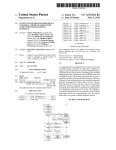
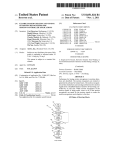
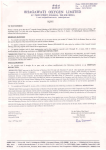
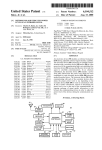
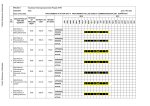
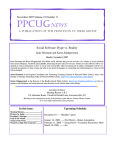
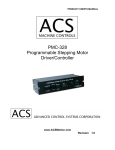
![[quote(var.text)]}](http://vs1.manualzilla.com/store/data/005937533_1-4dd3fe8a9b5a28fbfb6fbb268c8e3b66-150x150.png)
